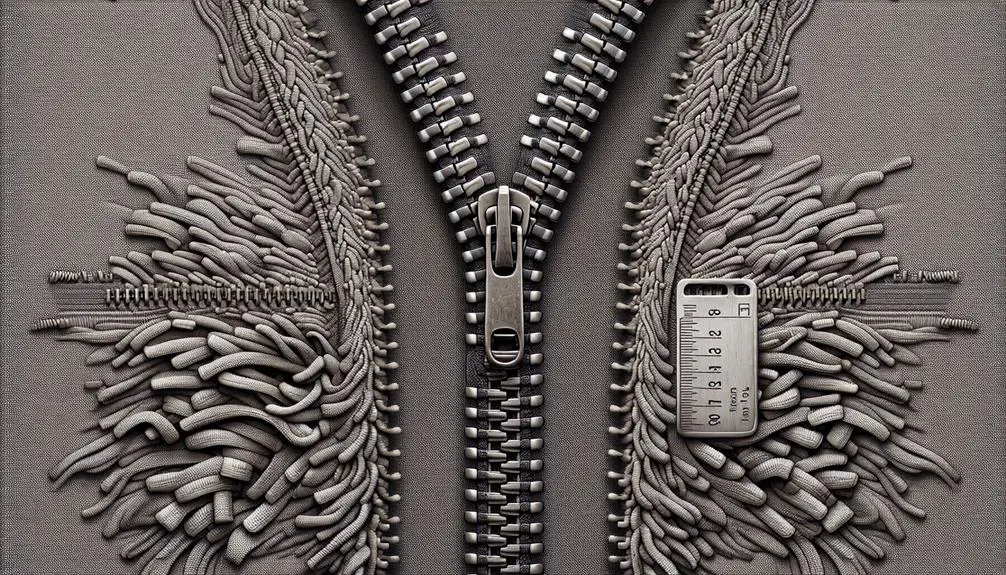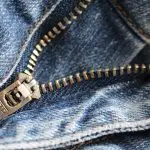In the world of fastenings, zippers play a silent yet pivotal role, knitting our fabrics together with their myriad of tiny guards. I've always been curious about the precise number of these guards, or teeth, as they're commonly known, that a zipper harbors. It seems like a straightforward question, but the answer is surprisingly complex, depending largely on the zipper's length and its intended purpose.
From my jacket's snug closure to the secure fastening of my backpack, each zipper's teeth count varies, raising intriguing questions about design and functionality. Let's explore this further, uncovering what lies beyond the simple zip and lock mechanism.
Table of Contents
Key Takeaways
- Zippers typically have about 10 teeth per inch, varying with size and design.
- Longer zippers may have more teeth, accommodating specialized needs and applications.
- The type of zipper teeth (coil, molded, metal) affects the total count and functionality.
- Proper maintenance ensures the longevity and smooth operation of all zipper teeth.
Understanding Zippers
To truly appreciate the intricacies of zippers, understanding that they often have about 10 teeth per inch, showcases a blend of precision and practical design. This detail might seem minor at first glance, but it's proof. For instance, a standard 4-inch zipper would contain roughly 40 teeth, a demonstration of the meticulous craftsmanship involved. It's not just about the number; the alignment of these teeth is critical. If they're not perfectly aligned, a zipper would easily jam or get stuck, turning a simple mechanism into a source of frustration.
The materials from which these teeth are crafted—nylon, plastic, or metal—further complicate the picture. Each material brings its own set of challenges and advantages. A zipper would behave differently depending on the material, affecting everything from its durability to how it should be maintained. Speaking of maintenance, it's not an optional chore. Regularly ensuring the teeth are clean and correctly aligned is paramount. Without this care, a zipper would quickly deteriorate, failing to serve its purpose.
Understanding these aspects, it becomes clear that the humble zipper is far from simple. It's a marvel of engineering that requires careful consideration, both in its creation and its upkeep.
The Anatomy of a Zipper
Let's break down the components of a zipper and see how they all work together to perform their essential function.
By understanding the role of each part, we can better appreciate the complexity behind this common fastener.
It's fascinating how something as small as zipper teeth plays such an essential role in keeping our fabrics securely joined.
Zipper Component Breakdown
Diving into the anatomy of a zipper reveals its complex structure, starting with the teeth, which are important for its function. Typically, a zipper has about 10 teeth per inch, a standard measure that shows how zipper teeth are distributed. The number of teeth varies with the zipper's length; longer zippers have more teeth.
These teeth are critical for securely fastening pieces of fabric, playing a significant role in the zipper's ability to open and close. For a zipper to operate smoothly, its teeth must be properly aligned, preventing any jamming or sticking. Regularly cleaning and aligning the teeth can greatly prolong a zipper's lifespan and functionality, ensuring it works as intended every time.
Zipper Functionality Explained
How do zippers work to seamlessly join pieces of fabric with such ease? The secret lies in their anatomy.
Zippers typically have between 4 to 30 teeth per inch, but the average sits around 10. These teeth, whether made from coil (nylon) or molded (plastic or metal), must align perfectly to avoid snags or jams. This precision guarantees a smooth glide with every zip and unzip.
The material choice—nylon for flexibility or metal for durability—factors into the zipper's function, catering to different needs. Regular maintenance, like keeping these teeth clean and well-aligned, is essential. It's not just about avoiding a stuck zipper; it's about ensuring longevity.
Understanding this balance of design and care is key for anyone looking to master the functionality of zippers.
Zipper Teeth Count Explained
Let's explore how the count of teeth on a zipper varies and why it matters.
I'll show you how to measure these teeth to understand what makes each zipper unique.
This knowledge not only helps in choosing the right zipper but also in maintaining its functionality over time.
Teeth Count Variability
The number of teeth on a zipper can greatly vary, depending on its length and type. From my experience, mastering the nuances of zipper teeth count is vital for anyone dealing with fabrics and fashion. Here's a quick rundown:
- Length Influence: Longer zippers often have more teeth, which makes sense for items like tents or luggage.
- Type Variability: Different types, such as separating and non-separating zippers, can have varying teeth counts.
- Average Range: Typically, you're looking at anywhere between 4 to 30 teeth for most applications.
- Exceptional Cases: Some specialized zippers may boast hundreds of teeth, especially for high-performance gear.
Understanding this variability is key. Proper teeth alignment guarantees smooth operation and prevents those frustrating moments when a zipper gets stuck.
Measuring Teeth Count
After exploring the variability of teeth counts in zippers, it's important to understand how to measure this feature for specific sewing projects.
A standard zipper typically boasts around 10 teeth per inch, providing a baseline for counting. For example, a 4-inch zipper will usually have about 40 teeth. However, it's important to remember that different types of zippers may have varying numbers of teeth, which impacts their functionality and design.
The teeth count is important for ensuring the zipper's smooth operation and durability. By grasping the relationship between zipper length and teeth count, I can select the right zipper for my projects, ensuring both the aesthetic and functional needs are met without a hitch.
Types of Zipper Teeth
Understanding the different types of zipper teeth is essential for selecting the right zipper for your project. The type of teeth impacts not just the zipper's appearance but its functionality and durability as well. Here's a breakdown of the main types:
- Coil Teeth: These are made of nylon and feature a continuous coil design. They're incredibly flexible, which allows for smooth operation along curves, making them a popular choice for garments and outdoor gear. Their adaptability doesn't compromise their strength, offering a reliable closure mechanism.
- Molded Teeth: These teeth are typically crafted from plastic or metal. They're individually shaped and fixed onto the zipper tape. Molded teeth zippers are known for their durability and strength, which is ideal for items that require robust construction like luggage or boots. However, they can be a bit more challenging to sew due to their rigid structure.
The type of teeth you choose should align with your project's needs, considering factors like flexibility, durability, and ease of use. Proper alignment of the teeth is also important for ensuring the zipper operates smoothly and doesn't get stuck, which can be a real hassle. Knowing these details helps me make informed decisions for my sewing projects, ensuring longevity and functionality.
Significance of Zipper Teeth
Having explored the different types of zipper teeth and their functionalities, it's now important to examine why these teeth are so significant. These tiny components are the backbone of the zipper's operation, securely holding fabric pieces together. Their importance can't be overstated; without them, the zipper wouldn't serve its primary function of fastening.
Proper alignment of these teeth is vital. It guarantees the zipper glides smoothly, without snagging or getting stuck. This is something we've all experienced—a zipper that won't budge can be incredibly frustrating. It's not just about convenience; it's about functionality. When the teeth are properly aligned, it's a seamless process to open and close a zipper, which is what we all expect from our garments and gear.
Additionally, the number of teeth per inch can vary based on the zipper type, affecting the zipper's overall performance. Regular cleaning and maintenance of these teeth are paramount. It's the key to prolonging a zipper's lifespan and maintaining its functionality. Furthermore, ensuring they're free of debris and correctly aligned can make all the difference in the world. It's these small details that contribute to the mastery of using and caring for zippers in our daily lives.
Zipper Teeth and Durability
The durability of a zipper's teeth, whether they're made of nylon, plastic, or metal, plays an essential role in its overall longevity and performance. As someone who's keen on the mechanics behind everyday items, I've come to appreciate the intricacies of zipper teeth and their impact on zipper functionality. Here's what I've learned:
- Material Matters: Nylon, plastic, and metal teeth each offer different pros and cons. Metal is robust but can corrode, while nylon and plastic provide flexibility and resistance to corrosion but might wear down faster.
- Maintenance is Key: Regular cleaning and occasional lubrication can significantly prolong the life of a zipper's teeth, ensuring they function smoothly for longer.
- Beware of Damage: Misaligned or broken teeth aren't just a nuisance; they're a sign of potential failure. Keeping teeth aligned guarantees seamless operation and prevents further damage.
- Choose Wisely: Coil and molded teeth zippers each have their unique advantages, with coil types generally offering more flexibility and molded types typically being more durable in harsh conditions.
Understanding these aspects hasn't only helped me choose the right zipper for my needs but also how to maintain them for maximum durability. It's a fascinating blend of material science and practical application that underscores the importance of seemingly small details in everyday objects.
Caring for Your Zipper
After exploring how zipper teeth impact their durability, let's focus on how to properly care for your zipper to make certain it endures as long as possible. Regular cleaning is a must. I make it a habit to gently brush away any dirt and debris that could cause the teeth to misalign. It's surprising how much grit can accumulate, especially on zippers of items used outdoors.
I've learned the hard way not to force a zipper closed if the teeth aren't lining up. Doing so can damage the teeth, leading to bigger issues. Instead, I take a moment to realign the teeth gently, ensuring a smooth closure.
Applying a specialized zipper lubricant has been a game-changer for me. It keeps the teeth moving smoothly and prevents them from sticking, which I find particularly useful for the zippers on my camping gear.
I also regularly inspect my zippers for any signs of wear, breakage, or misalignment. Catching problems early means I can often fix them before they become major.
Ultimately, I've found that being gentle with zippers, especially when opening and closing them, goes a long way in preserving their functionality. It's all about treating them with a bit of care.
Common Zipper Issues
Despite regular maintenance, I've encountered several common zipper issues that can disrupt their smooth operation. It's frustrating when you're in a hurry, and your zipper decides to act up. Over time, I've learned that understanding these problems is key to solving them effectively. Here's a breakdown of the most frequent issues:
- Misaligned Teeth: This is a real pain. When the teeth don't line up correctly, the zipper gets stuck, and I struggle to move it up or down. It feels like the zipper is fighting back, making it nearly impossible to operate smoothly.
- Broken or Missing Teeth: Even one missing tooth can ruin the whole zipper. It's like missing a vital piece of a puzzle; without it, the zipper can't secure the fabric properly, leaving gaps or refusing to close altogether.
- Worn Out or Damaged Teeth: Over time, teeth wear down or get damaged. This degradation leads to a zipper that's tough to open or close. It's like trying to run with a sprained ankle – painful and inefficient.
- Improperly Aligned Closure: When the zipper closure is off-kilter, it not only looks bad but also affects functionality. An uneven closure can mean the zipper won't shut completely or will look skewed, messing up the appearance and use of the item.
Regular inspection and quick action are my best bets for keeping zippers in top shape. It's all about catching these issues early to guarantee my zippers last as long as they're supposed to.
Frequently Asked Questions
What Is Tooth Size on a Zipper?
I've found that the size of a tooth on a zipper is typically about 1/16 inch wide. This size can slightly vary depending on the type and the manufacturer of the zipper.
What Are Zipper Teeth Called?
I've always called them 'zipper teeth' due to their resemblance to real teeth. They're the small, interlocking pieces that guarantee the zipper functions properly, whether they're made of metal, plastic, or nylon.
What Are Standard Zipper Sizes?
Standard zipper sizes vary, commonly ranging from 4 to 36 inches. They're measured by the length of the zipper tape, essential for choosing the right one for my sewing projects or repairs.
What Is the Difference Between a #5 and #8 Zipper?
I've learned that a #5 zipper has teeth about 5mm wide, suited for lighter garments, while a #8's teeth are roughly 8mm wide, better for heavier items. It's all about matching fabric weight and durability needs.
- How Does Ring Spun Cotton Affect Garment Fit and Shape Retention? - August 13, 2024
- What Are the Challenges in Producing Ring Spun Cotton? - August 13, 2024
- Is Ring Spun Cotton Suitable for Plus-Size Clothing? - August 13, 2024






